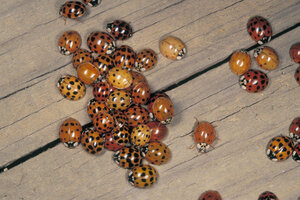Ladybug invasion
One homeowner finds that a winter ladybug invasion isn't so bad.

Multicolored Asian lady beetles (Harmonia axyridis) clustered together for hibernation. These ladybugs were first imported to the United States as a predator of aphids but often invade houses for the winter.
NEWSCOM/File
Maybe it’s a harbinger of bad insulation – or, on a more optimistic note, perhaps a sign of good fortune and an early spring – but my overwintering crop of ladybugs is waking up and beating at the windows to get out.
My first fall in Connecticut a few years back, the ladybugs in my garden (or ladybirds as some want to call them) slyly tucked into cracks and crevices in the façade of my house, over time making their way into the gentler temperatures indoors.
I recall a courageous few blowing in with the opening of a door, or flying purposefully through an open window. Eventually I’d find ladybugs stowed away over the winter months tucked behind curtains and into window jams.
It’s important to note that ladybugs are not structure-damaging pests – if touched or terrified, they can leave small stains as part of a defense reaction known as "reflex bleeding," which is intended to prevent predators from eating them. But they don’t enjoy meals of wood or fabric as other insects do – and I’ve never suffered a bite, although there some experts who swear they can land a well placed nip or two.
As a San Francisco Bay Area native, harboring ladybugs (rather willingly or unknowingly) inside the home is something I really hadn’t seen before. They manage to survive horrendous weather conditions by finding a reasonable place to hide and then falling into a state of “diapause” – in which their metabolism lowers and simultaneously, their freezing points, as they drop into dormancy or bug hibernation.
This is the reason ladybugs are often stored in refrigerators at garden centers where they rest until released into a deliciously aphid-laden garden. Ladybugs hiding in corners and crevices holding perfectly still may well be alive.
In older homes, hoards of ladybugs may be found in attics during the colder months – happily hunkered down in a quiet corner for a long winter’s nap. As insulation and better building practices advance, the tiny crevices and shrunken wood around windows that ladybugs rely on to gain entry into homes are getting harder to find.
My home has new windows and paint – making insect entry inside quite a project.
But well-sealed windows and doors notwithstanding, this past winter my ladybugs must have collectively realized they’ve found in me an agreeable host. I do tend to open windows quite a bit in the fall – hoping to catch some last gasps of fresh air before winter heating turns the house into a tightly sealed but somewhat stagnant micro environment. So in they come.
I have neighbors who are appalled by this notion. They run around the house with vacuum cleaner and dustpan in hand at the first sign of flitting orange spots, ridding the house of them.
If you’re not a fan of the notion of a hosting a ladybug hotel during the winter, caulk exterior cracks in the spring and summer before they come seeking refuge when the temps drop. Keep window and attic vent screens in good shape and be sure you have tight-fitting door sweeps in place on all exterior doors.
While I’ve probably painted a picture of swarms of orange in all corners of my house during the winter, generally I really don’t see wing or buzz of my ladybirds until the end of March – after the snow and ice have departed.
I was really heartened in mid-February when I found a few early risers ready to leave – flying against the windows to join the outside realm once again. Temps had began to rise earlier than normal and with the lengthening of days I saw this as an early sign of spring.
Every morning for the past few weeks, I’ve gently scraped them off the window panes and released them. I love watching as they fly off into the warm sunshine ready for the spring. At first there were just a few in colors ranging from bright orange to pale yellow; some with spots, most solid.
The past few mornings there’ve been upwards of 20 or more waiting to get out. These have been larger than the first and have many more black squiggles and markings than the early risers that first appeared a few weeks ago.
While I clearly have a collection on my hands most mornings, I’d love to see some of the red ladybugs I’ve seen described in books. Ladybugs can range from barely visible to nearly half an inch – and in a kaleidoscope of colors yellow and orange yes, but also scarlet, brown and solid black – making them easily mistaken for other types of beetles.
The world over, there are more than 5000 species of ladybugs – 450 alone here in North America. And while it’s just early March, most of my ladybugs are already gone – but I know they’ll keep me company all summer long in the garden.
Carrie Leber is author of the design and garden blog bloomacious.org, and owns the PR firm Leber Media Group.
Follow us on Twitter and Facebook.
Usually, Alexandra Marks blogs twice a week about her green and budget-friendly restoration of a 1902 farmhouse in Connecticut. She will resume blogging on March 23. Click here to find all her blog posts and articles.
